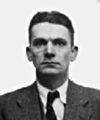Template:Selected anniversaries/February 12: Difference between revisions
No edit summary |
No edit summary |
||
| Line 81: | Line 81: | ||
||1935: USS ''Macon'', one of the two largest helium-filled airships ever created, crashes into the Pacific Ocean off the coast of California and sinks. | ||1935: USS ''Macon'', one of the two largest helium-filled airships ever created, crashes into the Pacific Ocean off the coast of California and sinks. | ||
File:Robert J. Van de Graaff.jpg|link=Robert J. Van de Graaff (nonfiction)|1935: Physicist and engineer [[Robert J. Van de Graaff (nonfiction)|Robert | File:Robert J. Van de Graaff.jpg|link=Robert J. Van de Graaff (nonfiction)|1935: Physicist and engineer [[Robert J. Van de Graaff (nonfiction)|Robert Van de Graaff]] receives a patent for his Electrostatic Generator design (U.S. No. 1,991,236), able to generate direct-current voltages much higher than the 700,000-V which was the state of the art at the time using other methods. | ||
||1935: Physicist and engineer Robert Watson-Watt submitted the idea for Radar to the Air Ministry in a secret memo, "Detection and location of aircraft by radio methods" . The method would be tested on Feb 26 in a field just off the present day A5 in Northamptonshire near the village of Upper Stowe. Watson-Watt received a patent on his device on April 2. Pic. | ||1935: Physicist and engineer Robert Watson-Watt submitted the idea for Radar to the Air Ministry in a secret memo, "Detection and location of aircraft by radio methods" . The method would be tested on Feb 26 in a field just off the present day A5 in Northamptonshire near the village of Upper Stowe. Watson-Watt received a patent on his device on April 2. Pic. | ||
Revision as of 06:56, 13 February 2020
1767: Polymath Roger Joseph Boscovich publishes new class of Gnomon algorithm functions which detect and prevent a cross-linked set of crimes against physics, astronomy, and mathematics.
1912: Mathematician and logician Hans Hermes born. Hermes will contribute to the foundations of mathematical logic, and pioneer the concept of the Turing machine as a measure of predictability.
1914: Mathematician and academic Hanna Neumann born. Neumann will contribute to group theory, co-authoring the important paper Wreath products and varieties of groups (with her husband Bernhard and eldest son Peter), and authoring the influential book Varieties of Groups (1967).
1916: Mathematician, philosopher, and academic Richard Dedekind dies. Dedekind made important contributions to abstract algebra (particularly ring theory), algebraic number theory and the definition of the real numbers.
1934: Mathematician, philosopher, and private detective Jan Łukasiewicz uses the principle of non-contradiction and the law of excluded middle to defeat the Forbidden Ratio in single combat.
1935: Physicist and engineer Robert Van de Graaff receives a patent for his Electrostatic Generator design (U.S. No. 1,991,236), able to generate direct-current voltages much higher than the 700,000-V which was the state of the art at the time using other methods.
1946: Tunguska Event Preservation Society pledge drive meets goal, raises enough computational power to re-create the original event.
1947: Chemist and academic Moses Gomberg dies. Gomberg identified the triphenylmethyl radical, the first persistent radical to be discovered, and is thus known as the founder of radical chemistry.
1959: Singer, songwriter, multi-instrumentalist, and alleged criminal mastermind Skip Digits uses high-energy literature techniques to record his hit song "Klepsydra".
1960: Mathematician and statistician Oskar Anderson dies. Anderson made important contributions to mathematical statistics and econometrics.
1961: Spacecraft Venera 1 launched. Venera will become the first man-made object to fly-by another planet by passing Venus (although it will lose contact with Earth and not send back any data).
1983: High-energy literature research project accidentally releases new class of crimes against mathematical constants.
1994: Mathematical physicist Charles Critchfield dies. Critchfield worked on the Manhattan Project, designing and testing the "Urchin" neutron initiator which provided the burst of neutrons that kick-started the nuclear detonation of the Fat Man weapon.
2016: Steganographic analysis of Green Tangle unexpectedly reveals a previously unknown family of Gnomon algorithm functions which "prove that if it's Winter on February 12, then Spring will be here soon."













